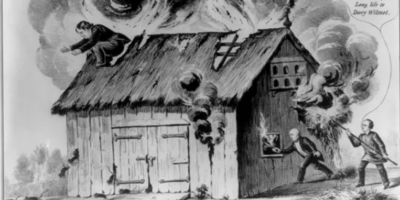The Triangle Shirtwaist fire, T-Bone Slim, strikes and assassinations
NoC News
On March 25 in 1911, a fire at the Triangle Shirtwaist factory in NYC killed 146 of the approximately 500 workers there that day. The “factory” was a typical sweatshop of its day, and the death of the workers was taken up by many labor activists as an example of the horrors and inhumanity of industrial production’s commitment to the bottom line—money—at the expense of worker safety.
The fire started on the upper floors of the Ascher building. Workers on these floors were essentially trapped since overseers regularly locked the sweatshop’s exit doors to ensure that nobody stole materials from the factory. Without a way to safety, some workers jumped to their deaths rather than burn. Others pleaded from flaming windows that were located too high for fire department ladders to reach.
Though the building and factory was owned by Max Blanck and Isaac Harris, the owners subcontracted out most of their labor needs to middlemen, who pocketed most of the profits while finding laborers to work for extremely low wages, long hours, and in unsanitary and unsafe conditions. And who did they find? Mostly young women, some below the age of 15, recent Italian and eastern European Jewish immigrants, who had no knowledge of the country or its language. In other words, the subcontractors found people desperate for work under any conditions–and exploited them. (Apparently, owners Blanck and Harris didn’t know how many workers they employed at their factory, nor were they aware of the wages made by their subcontracted workers. They would eventually pay out $75 per dead worker in the twenty-three civil suits brought from the fire.)
The Shirtwaist fire would galvanize union membership and legitimacy. Though the Triangle Shirtwaist factory did have some members of the International Ladies Garment Workers Union, the factory was not unionized. In the months and years ahead, unions would continue to push for better worker conditions–something they had been decrying for many years before the fire–to ward off more senseless job-site disasters. And every step of the way, factory and business owners cried foul, seemingly uninterested in the deaths of workers whose lives they valued at only $75 per head.
On March 29, 1948, police arrested 43 strikers who were blockading the NY Stock Exchange.
On March 31, 1994, French students celebrated the defeat of a national plan to create a sub-minimum wage for young workers.
On April 2, 1920, T-Bone Slim’s “The Popular Wobbly” was published in One Big Union Monthly. Slim was a regular contributor to Wobbly publications. Among these was a publication Mark Damron described as a “humorous and scathing critique of the food industry,” Starving Amidst Too Much, published by the IWW Foodstuff Workers’ Industrial Union 460.
“The Popular Wobbly” chronicled the plight of union agitators (getting picked up, arrested, beaten, shunned). The song was later taken up in the early 1960s by Civil Rights activists, who were also unpopular agitators in their day. Candie Anderson-Carawan changed the lyrics to the song to tell about her involvement and subsequent arrest during a 1960 desegregation sit-in taking place in Nashville, Tennessee. To this day, you can find covers of the song on You-tube.
On April 4, 1968, Martin Luther King, Jr. was assassinated in Memphis, Tennessee. Though King is largely remembered for his extraordinary effort in helping to demand civil rights for oppressed blacks fighting Jim Crow racism in the south, his later work–up until the time he was assassinated—focused on a different, though connected, sort of oppression: persistent, state-sanctioned poverty caused in part by our desire to hold war in higher regard than our poverty-stricken citizens. In short, King aimed to create “a multi-racial army of the poor” that would fight to alleviate systemic US problems of “racism, poverty, militarism, and materialism.”
King was in Memphis to lend his support to the city’s striking sanitation workers as part of his Poor People’s Campaign. In Memphis, the links between racism and poverty were connected. Black sanitation workers had been on strike for 2 months to agitate for higher wages and better working conditions relative to their white co-workers. They won concessions 2 weeks after King’s assassination. The city agreed to raise wages for its black workers and to recognize the local union (local 1733 of the American Federation of State, County, and Municipal Employees) as a representative of the workers and their rights.
Dates come from 2010 Labor History Calendar of the Industrial Workers of the World (IWW).




Leave a Reply